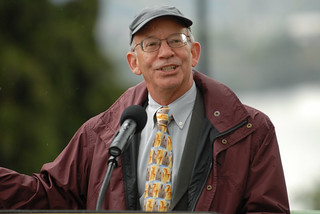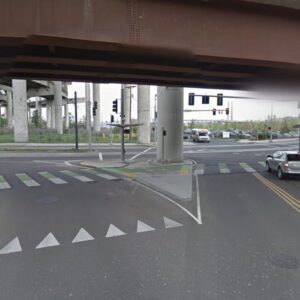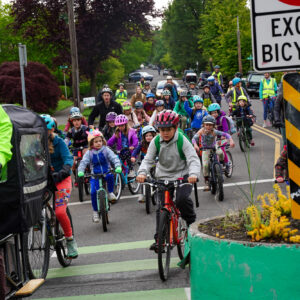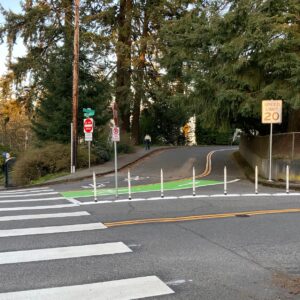Oregon Congressman Peter DeFazio — who likes to mention in speeches that he’s the only member of Congress who has ever worked as a bicycle mechanic — is taking his fight for safer bicycling to the United States Government Accountability Office.
Citing a “troubling increase in pedestrian and cyclist fatalities in recent years,” Rep. DeFazio has joined with fellow House Democrats Rick Larsen from Washington state and Eleanor Holmes Norton from the District of Columbia to request a GAO investigation into the issue.
In a statement released today, the trio said they want the GAO to investigate, “trends and causes of accidents involving pedestrians and bicycles and to make recommendations about improving safety.”
Advertisement
Here’s more from the statement:
“The safety of everyone on the road should be our top priority. Thanks to coordinated efforts, motor vehicle accident deaths are declining. But the same is not true for the most vulnerable people on our roadways – pedestrians and bicyclists. The GAO can give us a better idea of the reasons behind why pedestrian and cyclist fatalities are going up. We want to know what more Congress can do to ensure the highest level of safety for all of those using our roads,” said Larsen, DeFazio and Norton.
And here’s the text of their letter they’ve sent to Gene Dodaro, Comptroller General of the U.S. Government Accountability Office:
Dear Mr. Dodaro:
While overall traffic-related fatalities have been declining in recent years, our most vulnerable road users—pedestrians and cyclists—have experienced an increase in fatalities. In 2012, 4,743 pedestrians were killed, or an average of one fatality every two hours. Also in 2012, 726 cyclists were killed on our roads. These pedestrian and cyclist fatality totals each represent a 6 percent increase from 2011.
Furthermore, we are concerned that conventional engineering practices have encouraged engineers to design roads at 5-15 miles per hour faster than the posted speed for the street. This typically means roads are designed and built with wider, straighter lanes and have fewer objects near the edges, more turn lanes, and wider turning radii at intersections. While these practices improve driving safety, a suspected unintended consequence is that drivers travel faster when they feel safer. Greater speeds can increase the frequency and severity of crashes with pedestrians and cyclists who are moving at much slower speeds and have much less protection than a motorized vehicle affords.
Because of these increasing fatality numbers among the most vulnerable road users, we request that the Government Accountability Office (GAO) investigate the trends and causes of these roadway fatalities and the challenges associated with improving pedestrian and cyclist safety. In particular, we are interested in information about the relationship between vehicle speed and roadway fatalities, and how roadway design speeds and other common practices may exacerbate this problem. Accordingly, we would like for GAO to examine:
- The trends in pedestrian and cyclist accidents (including causes of such accidents), fatalities, and injuries in the last decade.
- Challenges that states face in improving pedestrian and cyclist safety (including roadway design speeds and FHWA guidelines for road design), and the initiatives states have undertaken to address this issue. We are particularly interested in the effects of the common road engineering standard that sets speed limits at the rate 85% of drivers would use under regular conditions.
- The extent that federal initiatives and funds been made available to assist states in improving pedestrian and cyclist safety, and additional federal actions that may be needed.
Thank you for your consideration.
Sincerely,
Rick Larsen
Member of CongressPeter DeFazio
Member of CongressEleanor Holmes Norton
Member of Congress
This formal request comes on the heels of other signs from Washington that attention on creating safer conditions for cycling is on the rise in Washington.
The latest budget passed by Congress included a provision pushed by the League of American Bicyclists to set a national goal to reduce biking and walking fatalities. And back in September, US Department of Transportation Secretary Anthony Foxx announced an 18-month campaign to, “reduce the growing number of pedestrian and bicyclist injuries and fatalities through a comprehensive approach that addresses infrastructure safety, education, vehicle safety and data collection.”







Thanks for reading.
BikePortland has served this community with independent community journalism since 2005. We rely on subscriptions from readers like you to survive. Your financial support is vital in keeping this valuable resource alive and well.
Please subscribe today to strengthen and expand our work.
I love this line “pedestrians and cyclists who are moving at much slower speeds and have much less protection than a motorized vehicle affords.” um… try Zero protection compared to motorized vehicles!
Once again the slowest machine in the world ticks over another “study” to decide if they want to make a decision on deciding to make decisions!
Bureaucrats… what a bunch of wind bags!
I think the increase in ped/bike collision deaths is directly related to the increased safety of driving a motor vehicle… the safer you feel the less you have to pay attention because no matter what happens you’re in a protective metal cage…
there are no direct consequences to you for crashing your motor vehicle into something… all the risks are external and not your immediate problem…
then once the crash is over and the legal part of the crash takes over there still aren’t any real consequences to the crash…
since we’re unlikely to require that vehicles have no safety equipment the most likely way to get drivers to care about the risks is to have real consequences for hurting other people…
but nobody wants real consequences until it hits close to home… drivers are absolutely dead-set against anything that will cause them to get caught breaking real safety laws and punish them for it…
I have to disagree with you on “the increase in ped/bike collision deaths is directly related to the increased safety of driving a motor vehicle”
I think the data would show that the increase collisions and deaths with ped/bike coincides with the increased infrastructure (ped and bike) and sheer growth of pedestrian and bikes being used for more than just recreational or excise.
Also I think that city density increases also coincide with higher pedestrian counts in most metropolitan regions, as well as more bike use in those regions.
I will add that you may be on to something along the lines that the majority of all motorized collisions (mostly auto “accidents”) are due to more careless driving and distracted driving from the false sense of security that the major safety improvements to automobiles has created.
I think if you guys really want to see data poke around the USDOT web site on extensive tracking and studies they’ve done on the subject for decades. Pedestrian fatalities were on a steady decline up until 2008 and they’ve risen ~4-5% annually since. Most fatalities occurred after 8 PM with the second highest concentration after 4 PM, which would make sense since it gets dark and more people are driving in the evenings. Other analysis also shows a jump in the age of pedestrians killed, seeming to correlate with the shift in demographics. I personally find the 2008 inflection point interesting, as it correlates with the last big recession putting so many people out of work (and scrutinizing their budgets). Also, one study I read did not find that distraction from mobile devices, while definitely a growing concern, contributed to pedestrian fatalities with any significance.
Hmm, Apple released the first iPhone in 2007. Wonder if there’s a correlation between the widespread adoption of touch screen phones and the increase in pedestrian and bicyclist deaths.
As I mentioned, that’s not what they found, but what I personally see on the road seems contrary. I guess one way to find out is to wait a few years to see if it progressively gets worse based on this new trend in technology: https://www.youtube.com/watch?v=l2WeTmTZAR4
(But of course it won’t since they’ve done it “safely”: http://www.volvocars.com/intl/about/our-innovations/intellisafe)
whoa, what study shows these things improve safety? to me it looks like all they do is speed up vehicles…
wider and straighter lanes with the visibility to see nothing in your direct path and a vehicle that can easily do twice the speed limit just encourages you to drive faster…
more turn lanes and wider radii means you don’t have to slow down…
those things encourage speed, and speed has never been safe…
Yeah, I don’t get the “While these practices improve driving safety” part. Drivers are safer because of advances in auto technology, not roadway design. Drivers are definitely driving faster, as the letter mentions, because of these changes. On one road I use frequently the speed limit is 35 MPH and I’d regularly see cars doing 45. This summer San Jose installed a mid-block pedestrian crossing there with signs, blinking lights, and request-activated HID lamps in the roadway. People seem to be driving closer to 35 MPH there since then.
I used to think my 2001 car was quiet, but the 2011 car I replaced it with does so much more to insulate me from outside noises. It’s nice, but it also requires attention to my speed. My elderly mother used to borrow it and she once got a ticket doing 80 MPH on I-84 – she had no idea she was going that fast. I think this contributes greatly to people speeding (and helps rationalize it), let alone on roadway designs that enable it… let alone that speed limits are enforced by people who spend their days driving around modern, quick, quiet cars themselves.
The results of a GAO study could very well prove fruitful in informing future legislation, not to mention persuading unconvinced colleagues when drafting it. It’s not a solution, it’s a step. Thanks Rep. DeFazio.
The increased danger of not being in a car in itself creates an increased ubiquity of automobile use, thus increasing the danger of not being in a car. It’s a viscous cycle exacerbated by the fact that driving a car is physically addictive, in that the more you drive the less able you are to get around by other means, increasing the amount of ubiquitous automobile use.
It seems like the easiest way to approach this problem is to take a big step and approach the issue as if the automobile had just been invented. How would we treat the introduction of a new type of machine into our society? Would we carefully control who was allowed to operate these machines and where they could do so or would we give over a significant portion of our world so that anyone who could apply for a loan could use their machines with little to no oversight? Would we blindly accept that the use of these new machines would cost dozens of thousands of lives of our friends and families each year?
The fact that so many people think that these are necessary evils is what I can’t understand. Alone each one of the problems that comes with a society centered around the automobile is unacceptable to me; that there are so many piled together is sickening.
Bravo. This is similar to a comment I made on LinkedIn about the role of the Internet of Things (IoT) in relation to “smart cities.” It’s a push that’s being made by tech companies and auto makers (to help leverage their investment in connecting the car) called Vehicle-to-Infrastructure (V2I) and it promises “safety and efficiency.” Back in the 50’s we let new technology (the affordable car) drive our infrastructure and we’re stuck in traffic on crumbling bridges now as a result. I firmly believe in the approach you advocate, but alas I doubt there’s short-term financial incentive to do so. Sigh.
“trends and causes of accidents involving pedestrians and bicycles”
Well, he could start by helping to change the language/framing we use by referring to “collisions” instead of “accidents.”
If I go roaming around the city swinging a hammer and not paying attention, I imagine that a jury wouldn’t buy my defense that when I hit someone, it was an “accident.”
The obvious (carhead) answer is that motorists must be doing it right, while pedestrians and bicyclists are doing it wrong. Besides, didn’t the Governors’ Highway Safety Association do this investigation?
I wouldn’t hold my breath for any reasonable conclusions to be drawn from a GAO investigation. I’m sure if we ask any number of motor-biased groups why pedestrians and bicyclists keep getting themselves run over, they would all agree that it’s because they weren’t being careful enough. Not enough hi-viz, being where they shouldn’t oughtta be, no helmets, out at the wrong time of night, etc.
I know, “cynical much?”
yep.
Yeah, the difference in the conclusions we tend to draw here in the US about fault and responsibility in pedestrian injuries and deaths vs. some European countries is sobering. I will again point to an article from 2011 in a Swiss paper about the distribution of fault where cars are running over people in crosswalks.
And then we have ODOT:
“In their statement about the See and be Seen effort, ODOT piles on a long list of statistics to make the case that when people are killed while walking in Oregon, it is usually their own fault.”
included in their list:
“33 of the 62 pedestrians killed (53%) were wearing dark clothing (not visible). This is up from an average of 23% over the last five years.”
http://bikeportland.org/2011/10/25/odot-to-distribute-reflective-arm-bands-to-keep-people-safe-on-our-roads-61013
Kudos to Representatives DeFazio, Larsen and Holmes Norton for this effort! This and the Vision Zero effort can help to change the way society thinks about our transportation infrastructure, and what is important for a livable society.
I do have one small point of contention: “…we are concerned that conventional engineering practices have encouraged engineers to design roads at 5-15 miles per hour faster than the posted speed for the street. This typically means roads are designed and built with wider, straighter lanes and have fewer objects near the edges, more turn lanes, and wider turning radii at intersections. While these practices improve driving safety, a suspected unintended consequence is that drivers travel faster when they feel safer.”
The phrase “…these practices improve driving safety” should read: “…these practices make drivers feel more comfortable going faster”.
Widening and straightening multiple lane roads, removing ‘objects’ near the edges, and increasing turning radii are not really safety features, they really only help cars and trucks think that they can move faster, at the expense of safety for themselves and others, because drivers now “feel” safe enough to go faster.
Speed kills. Wide lanes encourage speeding. Wide turning radii encourage speeding. Straight lanes encourage speeding. Wide open horizons encourage speeding. Multiple lanes create ‘multiple lane threats’, dangerous turning/passing motions, and greater ability to speed. These elements make it less safe for people driving, and for people walking, wheelchairing, scootering, skating and bicycling.
What actually increases safety (and improves the economy, air and health) is slowing traffic down some and increasing the ‘intrigue factor’, plus getting lots more people out there walking and bicycling, not making it easier to go fast. “Conventional engineering practices” have historically prioritized motor vehicle speed over safety. Fortunately, that is changing in many communities, to some extent, like Portland and Eugene and others. Federal highway (FHWA) is also changing, as is the engineering field, and starting to prioritize safety (and livability and health) over speed. Yeah! Hopefully that will last and GAO will ‘discover’ that traffic calming has greater benefits for society, but then there is the rest of Congress, and profit motives, and fear of change, and ideology, and…fingers crossed.
“…What actually increases safety (and improves the economy, air and health) is slowing traffic down some and increasing the ‘intrigue factor’, plus getting lots more people out there walking and bicycling, not making it easier to go fast. …” Robert Ping
If you’ve ever ridden or driven Germantown Rd north on the north side of the Tualitin Mountain here in Portland, that’s a fair example of road character that brings top speed capable on it, way down. Lots of close spaced, hairpin curves. Not that to apply that character of road design as a means of reducing speed road users are capable of traveling on any given road, would be good thinking, or a good idea. That’s because there are better, more effective ways of maintaining motor vehicle top speeds traveled, to safe levels.
Especially on big thoroughfares heavily used by people driving and otherwise traveling by motor vehicle, maximum speeds traveled could eventually, if not already, be better maintained by both road and vehicle light and electronic technology. Roads could be equipped with speed detection equipment that automatically collects data for issuing citations. Vehicles could be equipped with vehicle speed governors to maintain speeds at or below posted speeds as needed.
Improved engineering of new roads that DeFazio, Larsen, and Norton’s mention in their letter to the GAO, “…designed and built with wider, straighter lanes and have fewer objects near the edges, more turn lanes, and wider turning radii at intersections. …”, can help to create better visibility of vulnerable road users by people driving. This is good development for people traveling the road by means other than motor vehicle.
Good move though, on DeFazio, Larsen, and Norton’s part, to bring the focus onto looking into what things may have brought about increases in vulnerable road user injuries and deaths in recent years.
kudos, and right on! Its great to have elected representatives work to keep our populace safer for a change. De Fazio is the man!
It’s nice that anyone in office is taking the issue seriously. Hats off and a big ‘thank you’.
Hit-and-run pedestrian and bike deaths costs police departments lots of money, too.
Not long ago I read a report from my county’s Sheriff’s department that mentioned that approximately 50% of its operating budget is spent on traffic enforcement and collision response. (Personally I’d doubt that it’s that low, except we pay for a helicopter to fly over my house frequently and I think it’s not counted in this estimate).
What? You mean the nationwide campaign to get pedestrians to wear light-colored, or preferably reflectorized, clothing is not reducing pedestrian deaths?
Portland in your dreams: (Chiyoda, Japan webcam)
http://www.ustream.tv/channel/%E7%A7%8B%E8%91%89%E5%8E%9F%E3%83%A9%E3%82%A4%E3%83%96%E3%82%AB%E3%83%A1%E3%83%A9?utm_campaign=JPER&utm_medium=FlashPlayer&utm_source=embed